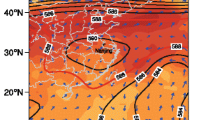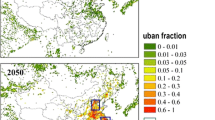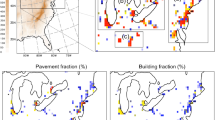Abstract
The impacts of three periods of urban land expansion during 1990–2010 on near-surface air temperature in summer in Beijing were simulated in this study, and then the interrelation between heat waves and urban warming was assessed. We ran the sensitivity tests using the mesoscaleWeather Research and Forecasting model coupled with a single urban canopy model, as well as high-resolution land cover data. The warming area expanded approximately at the same scale as the urban land expansion. The average regional warming induced by urban expansion increased but the warming speed declined slightly during 2000–2010. The smallest warming occurred at noon and then increased gradually in the afternoon before peaking at around 2000 LST—the time of sunset. In the daytime, urban warming was primarily caused by the decrease in latent heat flux at the urban surface. Urbanization led to more ground heat flux during the day and then more release at night, which resulted in nocturnal warming. Urban warming at night was higher than that in the day, although the nighttime increment in sensible heat flux was smaller. This was because the shallower planetary boundary layer at night reduced the release efficiency of near-surface heat. The simulated results also suggested that heat waves or high temperature weather enhanced urban warming intensity at night. Heat waves caused more heat to be stored in the surface during the day, greater heat released at night, and thus higher nighttime warming. Our results demonstrate a positive feedback effect between urban warming and heat waves in urban areas.
摘 要
城市化是改变区域气候特征的最为典型的人为活动之一. 本文模拟研究了1990-2010年北京城市用地扩展(3期土地利用数据)对夏季近地表气温的影响, 并评估了热浪与城市增温效应之间的相互关系. 方法是利用耦合了单层城市冠层模式的中尺度天气预报模型WRF模型, 以及高分辨率土地利用/覆被数据进行了敏感性试验. 结果表明, 城市扩展引起了近地表气温的升高, 这种增温的分布特征与城市土地扩张的分布格局基本相同, 但2000-2010年城市用地扩张引起的区域气温的平均升高强度比1990-2000年略有减少, 说明2000-2010年城市化区域增温效应的速度有所下降. 从城市化增温效应的日变化特征来看, 增温的最低值发生在中午, 之后增温强度逐渐增加, 并在日落时刻达到最高峰值. 在白天, 城市化增温效应主要是由城市地表潜热通量的减少引起的. 而夜间城市化增温效应的原因主要是城市在白天获得更多的地表储热, 使得夜间释放更多的热量. 夜间的大气边界层高度较小, 这使得虽然夜间感热通量的增量较小, 但夜间的城市平均增温强度大于白天. 热浪或高温天气增加了夜间的城市增温强度, 这是因为在热浪或高温天气期间, 城市地表储热在白天增加, 使得城市地表在夜晚释放更多的热量, 从而导致夜间城市化增温强度增加. 本文揭示了城市化增温效应与城市热浪(高温天气)之间的正反馈效应.
Similar content being viewed by others
References
Bai, G. Q., 2015: Simulation on the temperature and thermal flux about two kinds of surface layers. M.S. thesis, Nanjing University of Information Science & Technology. (in Chinese)
Cao, Q., D. Y. Yu, M. Georgescu, and J. G. Wu, 2016: Impacts of urbanization on summer climate in China: An assessment with coupled land-atmospheric modeling. J. Geophys. Res. Atmos., 121, 10 505–10 521, https://doi.org/10.1002/2016 JD025210.
Chen, F., and J. Dudhia, 2001: Coupling an advanced land surface–hydrology model with the Penn State–NCAR MM5 modeling system. Part I: Model implementation and sensitivity. Mon. Wea. Rev., 569–585, https://doi.org/10.1175/1520-0493(2001)129<0569:CAALSH>2.0.CO;2.
Chen, F., X. C. Yang, and W. P. Zhu, 2014: WRF simulations of urban heat island under hot-weather synoptic conditions: The case study of Hangzhou City, China. Atmospheric Research, 138, 364–377, https://doi.org/10.1016/j.atmosres.2013.12. 005.
Chen, F., H. Kusaka, M. Tewari, J. W. Bao, and H. Hirakuchi, 2004: Utilizing the coupled WRF/LSM/urban modeling system with detailed urban classification to simulate the urban heat island phenomena over the greater Houston area. Proc. 5th Symposium on the Urban Environment, American Meteorological Society, Vancouver, BC, Canada.
Chen, J., 2007: Rapid urbanization in China: A real challenge to soil protection and food security. Catena, 69, 1–15, https://doi.org/10.1016/j.catena.2006.04.019.
Cui, Y. P., J. Y. Liu, X. Z. Zhang, Y. C. Qin, and J. W. Dong, 2015: Modeling urban sprawl effects on regional warming in Beijing-Tianjing-Tangshan urban agglomeration. Acta Ecologica Sinica, 35, 993–1003, https://doi.org/10.5846/stxb 201305191114. (in Chinese)
Douglas, E. M., D. Niyogi, S. Frolking, J. B. Yeluripati, R. A. Pielke, N. Niyogi, C. J. Vörösmarty, and U. C. Mohanty, 2006: Changes in moisture and energy fluxes due to agricultural land use and irrigation in the Indian Monsoon Belt. Geophys. Res. Lett., 33, L14403, https://doi.org/10.1029/2006GL 026550.
Dudhia, J., 1989: Numerical study of convection observed during the winter monsoon experiment using a mesoscale twodimensional model. J. Atmos. Sci., 46, 3077–3107, https://doi.org/10.1175/1520-0469(1989)046<3077:NSOCOD>2.0.CO;2.
Fang, C. L., G. D. Li, and S. J. Wang, 2016: Changing and differentiated urban land scape in China: Spatiotemporal patterns and driving forces. Environ. Sci. Technol., 50, 2217–2227, https://doi.org/10.1021/acs.est.5b05198.
Feng, J. M., J. Wang, and Z. W. Yan, 2014: New advances in the research of climatic effect of urbanization. Advances in Meteorological Science and Technology, 4, 21–29, https://doi.org/10.3969/j.issn.2095-1973.2014.05.002. (in Chinese)
Feng, J. M., Y. L. Wang, Z. G. Ma, and Y. H. Liu, 2012: Simulating the regional impacts of urbanization and anthropogenic heat release on climate across China. J. Climate, 25, 7187–7203, https://doi.org/10.1175/JCLI-D-11-00333.1.
Field, C. B., and Coauthors, 2012: Managing the Risks of Extreme Events and Disasters to Advance Climate Change Adaptation. Special Report of the Intergovernmental Panel on Climate Change. Cambridge University Press.
Hales, S., 2015: Quantitative Risk Assessment of the Effects of Climate Change on Selected Causes of Death, 2030s and 2050s. World Health Organization, Geneva.
Hong, S. Y., J. Dudhia, and S. H. Chen, 2004: A revised approach to ice microphysical processes for the bulk parameterization of clouds and precipitation. Mon. Wea. Rev., 132, 103–120, https://doi.org/10.1175/1520-0493(2004)132 <0103:ARATIM>2.0.CO;2.
Hong, S. Y., Y. Noh, and J. Dudhia, 2006: A new vertical diffusion package with an explicit treatment of entrainment processes. Mon. Wea. Rev., 134, 2318–2341, https://doi.org/10.1175/MWR3199.1.
Jacobson, M. Z., S. V. Nghiem, A. Sorichetta, and N. Whitney, 2015: Ring of impact from the mega-urbanization of Beijing between 2000 and 2009. J. Geophys. Res. Atmos., 120, 5740–5756, https://doi.org/10.1002/2014JD023008.
Kain, J. S., 2004: The Kain-Fritsch convective parameterization: An update. J. Appl. Meteor., 43, 170–181, https://doi.org/10.1175/1520-0450(2004)043<0170:TKCPAU>2.0.CO;2.
Kalnay, E., and M. Cai, 2003: Impact of urbanization and land use change on climate. Nature, 423, 528–531, https://doi.org/10.1038/nature01675.
King, D., D. Schrag, D. D. Zhou, Q. Ye, and A. Ghosh, 2015: Climate Change: A Risk Assessment. Centre for Science and Policy.
Kusaka, H., and F. Kimura, 2004: Thermal effects of urban canyon structure on the nocturnal heat island: Numerical experiment using a mesoscale model coupled with an urban canopy model. J. Appl. Meteor., 43, 1899–1910, https://doi.org/10.1175/JAM2169.1.
Kusaka, H., F. Chen, M. Tewari, J. Dudhia, D. O. Gill, M. G. Duda, W. Wang, and Y. Miya, 2012: Numerical simulation of urban heat island effect by the WRF model with 4-km grid increment: An inter-comparison study between the urban canopy model and slab model. Journal of the Meteorological Society of Japan, 90B, 33–45, https://doi.org/10.2151/jmsj.2012-B03.
Kusaka, H., H. Kondo, Y. Kikegawa, and F. Kimura, 2001: A simple single-layer urban canopy model for atmospheric models: Comparison with multi-layer and slab models. Bound.-Layer Meteor., 101, 329–358, https://doi.org/10.1023/A: 1019207923078.
Li, D., and Bou-Zeid, E., 2013: Synergistic interactions between urban heat island s and heat waves: the impact in cities is larger than the sum of its parts. Journal of Applied Meteorology and Climatology, 52, 2051–2064, https://doi.org/10.1175/JAMC-D-13-02.1.
Meng, W. G., Y. X. Zhang, J. N. Li, W. S. Lin, G. F. Dai, and H. R. Li, 2011: Application of WRF/UCM in the simulation of a heat wave event and urban heat island around Guangzhou. Journal of Tropical Meteorology, 17, 257–267, https://doi. org/10.3969/j.issn.1006-8775.2011.03.007.
Miao, S. G., F. Chen, M. A. LeMone, M. Tewari, Q. C. Li, and Y. C. Wang, 2009: An observational and modeling study of characteristics of urban heat island and boundary layer structures in Beijing. Journal of Applied Meteorology and Climatology, 48, 484–501, https://doi.org/10.1175/2008JAMC1909.1.
Mlawer, E. J., S. J. Taubman, P. D. Brown, M. J. Iacono, and S. A. Clough, 1997: Radiative transfer for inhomogeneous atmospheres: RRTM, a validated correlated-k model for the longwave. J. Geophys. Res., 102, 16 663–16 682, https://doi.org/10.1029/97JD00237.
National Bureau of Statistics PRC, 2014: China Statistical Yearbook. China Statistics Press. (in Chinese)
Oke, T. R., 1982: The energetic basis of the urban heat island. Quart. J. Roy. Meteor. Soc., 108, 1–24, https://doi.org/10.1002/qj.49710845502.
Skamarock, W. C., and Coauthors, 2008: A description of the advanced research WRF version 3. NCAR Technical Note, NCAR/TN-475+STR, https://doi.org/10.5065/D68S4MVH.
Stott, P. A., D. A. Stone, and M. R. Allen, 2004: Human contribution to the European heatwave of 2003. Nature, 432, 610–614, https://doi.org/10.1038/nature03089.
Sun, Y., X. B. Zhang, F. W. Zwiers, L. C. Song, H. Wan, T. Hu, Y. Hong, and G. Y. Ren, 2014: Rapid increase in the risk of extreme summer heat in Eastern China. Nat. Clim. Change, 4, 1082–1085, https://doi.org/10.1038/nclimate2410.
Sun, Y., X. B. Zhang, G. Y. Ren, F. W. Zwiers, and T. Hu, 2016: Contribution of urbanization to warming in China. Nat. Clim. Change, 6, 706–709, https://doi.org/10.1038/nclimate2956.
Tewari, M., F. Chen, H. Kusaka, and S. G. Miao, 2007: Coupled WRF/Unified Noah/Urban-canopy modeling system. Ncar WRF Documentation, NCAR, Boulder.
Wang, J., J. M. Feng, and Z.W. Yan, 2015a: Potential sensitivity of warm season precipitation to urbanization extents: Modeling study in Beijing-Tianjin-Hebei urban agglomeration in China. J. Geophys. Res. Atmos., 120, 9408–9425, https://doi.org/10.1002/2015JD023572.
Wang, J., Z. W. Yan, X. W. Quan, and J. M. Feng, 2017a: Urban warming in the 2013 summer heat wave in eastern China. Climate Dyn., 48, 3015–3033, https://doi.org/10.1007/s00382-016-3248-7.
Wang, J., J. M. Feng, Z. W. Yan, Y. H. Hu, and G. S. Jia, 2012: Nested high-resolution modeling of the impact of urbanization on regional climate in three vast urban agglomerations in China. J. Geophys. Res., 117, https://doi.org/10.1029/2012JD018226.
Wang, J., Z. W. Yan, Z. Li, W. D. Liu, and Y. C. Wang, 2013a: Impact of urbanization on changes in temperature extremes in Beijing during 1978-2008. Chinese Science Bulletin, 58, 4679–4686, https://doi.org/10.1007/s11434-013-5976-y.
Wang, K. C., S. J. Jiang, J. K. Wang, C. L. Zhou, X. Y. Wang, and X. Lee, 2017b: Comparing the diurnal and seasonal variabilities of atmospheric and surface urban heat island s based on the Beijing urban meteorological network. J. Geophys. Res. Atmos., 122, 2131–2154, https://doi.org/10.1002/2016 JD025304.
Wang, M. N., X. D. Yan, J. Y. Liu, and X. Z. Zhang, 2013b: The contribution of urbanization to recent extreme heat events and a potential mitigation strategy in the Beijing–Tianjin–Hebei metropolitan area. Theor. Appl. Climatol., 114, 407–416, https://doi.org/10.1007/s00704-013-0852-x.
Wang, X. M., X. G. Sun, J. P. Tang, and X. Q. Yang, 2015b: Urbanization-induced regional warming in Yangtze River Delta: Potential role of anthropogenic heat release. International Journal of Climatology, 35, 4417–4430, https://doi.org/10.1002/joc.4296.
Xie, Z., and H. X. Cao, 1996: Asymmetric changes in maximum and minimum temperature in Beijing. Theor. Appl. Climatol., 55, 151–156, https://doi.org/10.1007/BF00864710.
Yan, Z. W., Z. Li, Q. X. Li, and P. Jones, 2010: Effects of site change and urbanisation in the Beijing temperature series 1977-2006. International Journal of Climatology, 30, 1226–1234, https://doi.org/10.1002/joc.1971.
Zhang, N., L. F. Zhu, and Y. Zhu, 2011: Urban heat island and boundary layer structures under hot weather synoptic conditions: A case study of Suzhou city, China. Adv. Atmos. Sci., 28, 855–865, https://doi.org/10.1007/s00376-010-0040-1.
Zhou, L. M., R.E. Dickinson, Y. H. Tian, J. Y. Fang, Q. X. Li, R. K. Kaufmann, C. J. Tucker, and R. B. Myneni, 2004: Evidence for a significant urbanization effect on climate in China. Proceedings of the National Academy of Sciences of the United States of America, 101, 9540–9544, https://doi.org/10.1073/pnas.0400357101.
Acknowledgements
This work was supported by the National Basic Research Program of China (Grant No. 2015CB953602) and the National Social Science Fund of China (Grant No. 17BGL256).
Author information
Authors and Affiliations
Corresponding author
Rights and permissions
About this article
Cite this article
Liu, X., Tian, G., Feng, J. et al. Modeling the Warming Impact of Urban Land Expansion on Hot Weather Using the Weather Research and Forecasting Model: A Case Study of Beijing, China. Adv. Atmos. Sci. 35, 723–736 (2018). https://doi.org/10.1007/s00376-017-7137-8
Received:
Revised:
Accepted:
Published:
Issue Date:
DOI: https://doi.org/10.1007/s00376-017-7137-8




